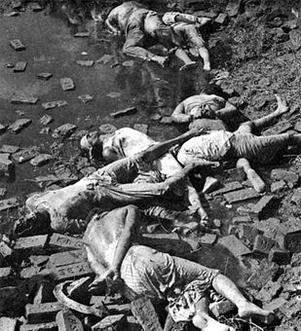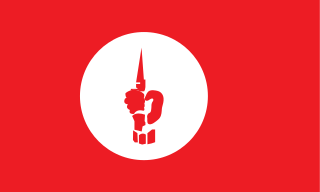Related Research Articles

The Bangladesh Liberation War was a revolution and armed conflict sparked by the rise of the Bengali nationalist and self-determination movement in East Pakistan, which resulted in the independence of Bangladesh. The war began when the Pakistani military junta based in West Pakistan—under the orders of Yahya Khan—launched Operation Searchlight against the people of East Pakistan on the night of 25 March 1971, initiating the Bangladesh genocide.
Muhammad Ataul Gani Osmani, was a Bengali military leader. Osmani's career spanned five decades, beginning with service in the British Indian Army in 1939. He fought in the Burma Campaign during World War II. After the partition of India in 1947, he joined the Pakistan Army and served in the East Bengal Regiment, retiring as a colonel in 1967. Osmani joined the Provisional Government of Bangladesh in 1971 as the commander-in-chief of the nascent Bangladesh Forces. Regarded as the founder of the Bangladesh Armed Forces, Osmani retired as a four-star general from the Bangladesh Army in 1972.

The Liberation War Museum is a museum at Agargaon in Dhaka, the capital of Bangladesh, which commemorates the Bangladesh Liberation War that led to the independence of Bangladesh from Pakistan.

Rajshahi District is a district in mid-western Bangladesh. It is a part of the Rajshahi Division. The metropolitan city of Rajshahi is in Rajshahi District.

The Bangladesh genocide was the ethnic cleansing of Bengali Hindus residing in East Pakistan during the Bangladesh Liberation War, perpetrated by the Pakistan Armed Forces and the Razakars. It began on 25 March 1971, as Operation Searchlight was launched by West Pakistan to militarily subdue the Bengali population of East Pakistan; the Bengalis comprised the demographic majority and had been calling for independence from the Pakistani state. Seeking to curtail the Bengali self-determination movement, erstwhile Pakistani president Yahya Khan approved a large-scale military deployment, and in the nine-month-long conflict that ensued, Pakistani soldiers and local pro-Pakistan militias killed between 300,000 and 3,000,000 Bengalis and raped between 200,000 and 400,000 Bengali women in a systematic campaign of mass murder and genocidal sexual violence. In their investigation of the genocide, the Geneva-based International Commission of Jurists concluded that Pakistan's campaign involved the attempt to exterminate or forcibly remove a significant portion of the country's Hindu populace.
Razakar Urdu: رضا کار, literally "volunteer"; Bengali: রাজাকার) was an East Pakistani paramilitary force organised by General Tikka Khan in then East Pakistan, now called Bangladesh, during the Bangladesh Liberation War in 1971. The force committed war crimes during the war including massacring civilians, looting, and rape.
The Swadhin Bangla Biplobi Parishad was an armed underground student political group secretly organized in 1961 by Serajul Alam Khan, a key founder of Bangladesh, that worked to wage an armed secessionist struggle against Pakistani rule and achieve the independence of East Pakistan as "Bangladesh".
The Bangladesh Liberation War started on 26 March 1971 and ended on 16 December 1971. Some of the major events of the war are listed in the timeline below.
The Al-Shams was an anti-Bangladesh paramilitary wing of several Islamist parties in East Pakistan composed of local Bengalis and Muhajirs that along with the Pakistan Army and the Al-Badr, is accused of conducting a mass killing campaign against Bengali nationalists, civilians, religious and ethnic minorities during 1971. The group was banned by the independent government of Bangladesh, but most of its members had fled the country during and after the Bangladesh Liberation War, which led to Bangladesh's independence.
East Pakistan Central Peace Committee, also known as the Nagorik Shanti Committee, or more commonly Peace Committee or Shanti Committee, was one of several committees formed in East Pakistan in 1971 by the Pakistan Army to aid its efforts in crushing the struggle for Bangladesh's liberation. Nurul Amin, as a leader of Pakistan Democratic Party, led the formation of the Shanti Committee to thwart the Mukti Bahini who fought for the liberation of Bangladesh. Bangladesh Genocide Remembrance Day is held in the memory of victims of 1971 Bangladesh genocide and massacre by Pakistan Army and organisations created and abetted by Pakistan Army such as Razakars and so-called "East Pakistan Central Peace Committee".

Pakistan and Bangladesh are both South Asian Muslim-majority countries. Following the end of British rule in India, the two countries formed a single state for 24 years. The Bangladesh Liberation War in 1971 resulted in the secession of East Pakistan as the People's Republic of Bangladesh. Pakistan recognized Bangladesh in 1974 after pressure from across the world. Today, bilateral relations between Bangladesh and Pakistan are considered to be cordial.

1971 Dhaka University massacre refers to the massacre of students and faculty at the University of Dhaka in East Pakistan by the Pakistan Army, at the beginning of what would become the Bangladesh Liberation War. In March 1971, the Pakistan Army Eastern Wing Commander Tikka Khan launched Operation Searchlight on the orders of dictator Yahya Khan to crush the Bengali nationalist movement. As part of the operation, the army launched an assault on the university campus. It is the deadliest university attack in history.

Santahar is a railway junction in Adamdighi Upazila in Bogra District of Rajshahi Division in Bangladesh.
The Golahat massacre was a massacre of 437 emigrating Hindu merchants and businessmen of Marwari ethnicity in Saidpur, East Pakistan on 13 June 1971, by the Urdu-speaking Muslim people of the area who had collaborated with the Pakistan army.
Shankharibazar massacre was a massacre of over 212 Bengali Hindus in the Shankharibazar area of Old Dhaka in East Pakistan on 26 March 1971 by the Pakistani occupation army. The survivors fled to the villages on the other side of the Buriganga, in the region now known as Keraniganj. Shankharibazar became deserted and dead bodies remained on the streets for quite a long time. The Pakistani establishment renamed the Shankharibazar Road to Tikka Khan Road.

The Mukti Bahini, also known as the Bangladesh Forces, was the guerrilla resistance movement consisting of the Bangladeshi military, paramilitary and civilians during the Bangladesh Liberation War that transformed East Pakistan into Bangladesh in 1971. They were initially called the Mukti Fauj.
The "Bihari" minority in Bangladesh were subject to persecution during and after the 1971 Bangladesh Liberation War, experiencing widespread discrimination. Biharis were ethnic Urdu-speakers and largely maintained a pro-Pakistani stance, supported the Pakistan Armed Forces and opposed the independence of Bangladesh and the Bengali language movement of the Bengali Muslims. Biharis faced reprisals from Mukti Bahini and militias resulting in an estimated death toll ranging from 1,000 to 150,000.
ABM Nurul Alam or Abu Barek Mohammad Nurul Alam was a Bangladesh physician who was killed in the Bangladesh Liberation war. He is considered a martyr in Bangladesh.
The Sohagpur massacre was a mass killing of 187 civilians on 25 July 1971 in the Mymensingh District of East Pakistan during the Liberation War. The massacre was perpetrated by the Pakistan Army and Al-Badr, a paramilitary force opposing Bangladeshi independence. Following the massacre, Sohagpur became known as the "village of widows."
Maleka Khan is a Bangladeshi social worker and activist for the rights of the Birangana, women raped during the Bangladesh Liberation War in 1971.
References
- 1 2 AFP (2011-11-23). "Bangladesh war trial sparks rival calls for justice". DAWN.COM. Retrieved 2023-04-26.
- ↑ "Controversial book accuses Bengalis of 1971 war crimes". BBC News. 2011-06-16. Retrieved 2023-04-26.
- ↑ Times, Sydney H. Scranberg Special to The New York (1972-03-17). "Bengalis Ashamed Of Burst of Revenge Against the Biharis". The New York Times. ISSN 0362-4331 . Retrieved 2023-05-08.
- 1 2 3 4 5 6 7 8 9 10 "Fall of Dhaka: How Mukti Bahini 'cleansed' Santahar town of non-Bengalis". The Express Tribune. 2017-12-15. Retrieved 2023-04-26.
- 1 2 "Fall of Dhaka: Winemaker's tale of selfless love and sacrifice". The Express Tribune. 2018-12-15. Retrieved 2023-04-26.
- ↑ Tubes, Urdu. B&T: B&T. Urdu-Books-Tube.